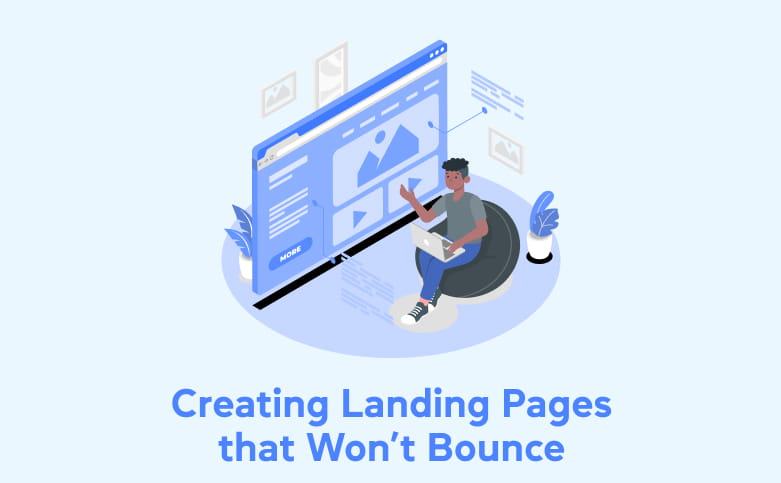Creating Landing Pages that Won’t Bounce
Your PPC campaigns are sending you visitors, but you’re not happy with the conversions. What could be wrong? You look at Google Analytics and notice that your Bounce Rate is around 70%. That sounds high. Could it mean that 70% of your visitors are “bouncing” off your landing page without taking any action? Unfortunately, yes.
In this post, we’ll explain everything you need to know about bounce rate, why it’s bad for business, and most importantly, how to reduce it.
What is Bounce Rate?

Bounce rate is the percentage of visitors who leave your landing page within 10 seconds, without taking any action. In other words, they abandon your site without interacting with it any further. That means no browsing, no purchases, no queries, no leads; nothing but a missed opportunity.
You can add the bounce rate metric to the Pages and screens report or other reports from your Google Analytics dashboard and keep an eye on it when tracking your PPC campaigns.
Why is Bounce Rate Bad for Business?
A high bounce rate can not only throttle conversions, it can also flush your PPC dollars down the drain. It indicates that visitors are not finding what they’re looking for, so they’re turning away from your landing page. This can ultimately lead to a loss of potential customers and revenue for your business.
To add injury to insult, a high bounce rate can also hurt your website’s search engine rankings. It tells Google that your website isn’t providing a good user experience and isn’t addressing the relevant search queries.
What is a Good Bounce Rate?
Ideally, you’d love to have a bounce rate of zero. Unfortunately, that simply isn’t realistic. You can’t be everything for everyone. In general terms, the bounce rate for most websites is somewhere between 70% and 26%. The ideal bounce rate varies depending on your industry and the type of website you have.
Data from SEMRush and HubSpot suggests a bounce rate of between 26% and 40% is good for most businesses. With the latest SEO tools and optimisation techniques that we use, we consider a bounce rate above 45% to be high, and therefore, an opportunity for improvement.
Strategies to Reduce Your Landing Page Bounce Rate
The first step in reducing your bounce rate is working out what is causing people to leave so quickly. Are you using the right keywords to run your campaigns? Is the content on your landing page relevant to the user intent? Is the page too slow to load, or is there some other reason for the high bounce rate? The following tips can help you narrow down your search and address the common problems that cause a high bounce rate.
Reduce Load Time
Data from website monitoring and speed-testing tool Pingdom suggests that the average load time for a web page is 3.21 seconds. If your website takes much longer to load, you run the risk of visitors getting impatient and leaving.
To improve your website’s load time, you can try compressing images, minimising HTTP requests, and reducing the number of plugins or scripts on your site. You can also use a content delivery network (CDN) to serve your website’s content from servers located closer to your visitors.
Optimise for Mobile

More than 92% of internet users now use mobile devices to browse the web. If your website isn’t mobile-friendly, the formatting goes haywire, navigation and user experience suffers and load times can be affected. This can lead to visitors leaving and bounce rate spiking.
To optimise your website for mobile devices, you can use a responsive design that adapts to different screen sizes. Make sure your website’s font size is readable on smaller screens, and images and videos that are optimised for mobile devices.
Improve Landing Page Content & Navigation
The average user has an attention span of just eight seconds. In other words, if visitors can’t find what they’re looking for within eight seconds, they’re likely to leave.
That’s why it’s critical to have a clear and compelling hero headline and image or video. After you succeed in capturing their attention, try to make them stay and engage with your content. Create a simple and clean design with intuitive navigation that makes it easy for them to find the information they need.
Reduce Distractions & Pop-ups
While pop-ups and interstitials can be effective at capturing visitors’ attention and leads, they can also be annoying and drive visitors away. If you use pop-ups or other distractions on your site, make sure they’re relevant and not intrusive. If you have to use pop-ups, use interstitial ads that appear when the user performs an action.
You can use exit-intent pop-ups that only appear when visitors are about to leave your site. You can also limit the frequency of interstitials you use and ensure they’re easy to dismiss.
Conclusion
Bounce rate is an important metric to track for anyone running an online business. A high bounce rate can indicate a poor user experience and lead to lost revenue and lower search engine rankings. By implementing the strategies we’ve outlined in this post, you can reduce your website’s bounce rate and provide a better experience to your visitors.
As one of Melbourne’s premier SEO agencies, we can help reduce website bounce rate, leading to increased conversions, purchases and leads for your business.








